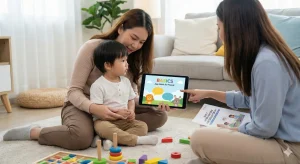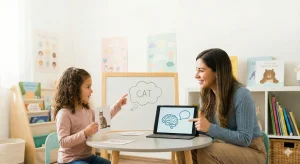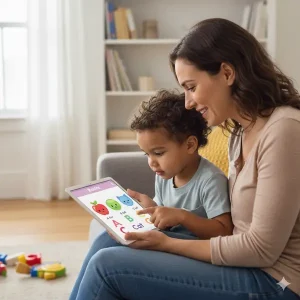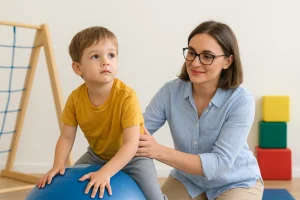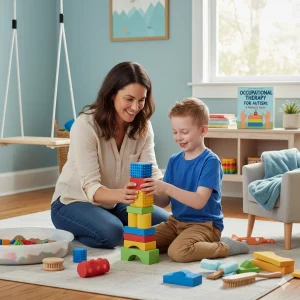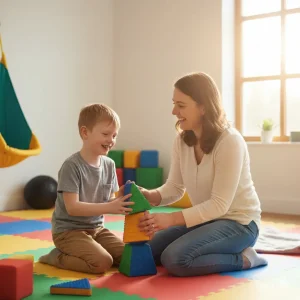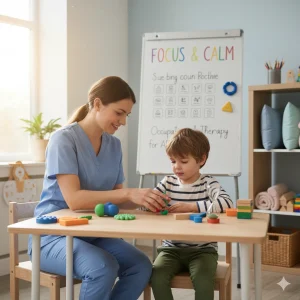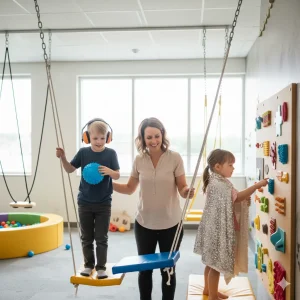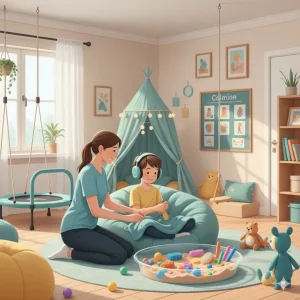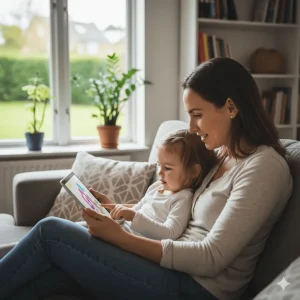How BASICS App Encourages Joint Attention and Eye Contact Through Play
By Wellness Hub
Last Updated: October 22, 2025
When your child looks at something you’re pointing to—or meets your eyes with a smile—it’s more than a sweet moment. It’s called joint attention, one of the first building blocks of communication. For many children with autism or speech delays, developing this shared focus can be challenging. That’s where the BASICS App steps in—turning everyday play into a bridge for eye contact, connection, and learning.
Through colorful visuals, fun sounds, and interactive games, BASICS app encourages children to look, respond, and engage naturally—without pressure. Whether your child is tapping, matching, or watching real-life videos, every activity is designed by therapists to strengthen joint attention, focus, and early social skills in a playful way.
In this guide, let’s explore how the BASICS App helps children build eye contact and engagement through meaningful play, and why these early skills are so important for communication growth.
Understanding Joint Attention and Eye Contact in Child Development
What joint attention means and why it’s a key social communication milestone
Joint attention means sharing focus on the same object or activity with another person. It’s the simple act of your child looking at something you point to or following your gaze to see what you’re seeing. This shared moment builds the foundation for language, imitation, and social connection.
When a child develops joint attention, they’re learning that communication isn’t just about words—it’s about looking, noticing, and responding together. It’s one of the earliest communication milestones, typically emerging between 9 and 18 months of age. Without it, conversation and social play become harder to build later on.
The link between eye contact, shared attention, and social learning
Eye contact is the doorway to joint attention. When a child meets your eyes, it signals awareness and engagement—it’s how they begin to read emotions, learn gestures, and understand meaning. Through eye contact and shared attention, children start connecting what they see with the words they hear. For example, when a parent points to a cat and says “cat,” the child links the sound of the word with the image they’re focusing on. This process fuels early vocabulary growth and emotional bonding, making eye contact one of the strongest predictors of language and social development.
Early red flags: when children avoid eye contact or don’t follow gaze
Some children naturally take longer to build eye contact or follow another person’s gaze. However, consistent signs such as not looking when their name is called, avoiding shared focus, or preferring to play alone may signal difficulties in joint attention development. These behaviors often appear during the toddler years and can make it harder for children to learn through imitation or shared play. Recognizing these early red flags helps parents and therapists begin gentle, play-based interventions that encourage connection and curiosity instead of pressure.
Read More: Speech Delay Red Flags: What to Watch for Between 18–24 Months
Why children with autism or speech delay often struggle with joint attention
Children with autism spectrum disorder (ASD) or speech delays may find it difficult to engage in joint attention because they process sensory and social information differently. They might focus more on objects than faces or find direct eye contact overwhelming.
This isn’t a lack of interest—it’s often a difference in how their brain interprets social cues. With support, many children learn to build these skills through structured, visual, and play-based activities, such as those in the BASICS App. Games that involve pointing, matching, or watching modeled interactions help them connect actions, faces, and meaning at their own pace.
Encouraging joint attention and eye contact in autism through play gives children the chance to communicate, share joy, and take the first steps toward social understanding—one gaze at a time.
Why Play is the Foundation for Building Connection
Play is how children make sense of the world. It’s through play that they learn to notice, respond, and connect—the very skills that form the roots of communication. When children share a toy, laugh at a silly sound, or copy an action, they’re not just having fun—they’re practicing joint attention, one of the most important communication milestones in early development.
How Play-Based Learning Supports Social Engagement and Shared Focus
Play creates a natural setting for shared attention. When a child follows your gaze toward a moving ball or responds when you take turns stacking blocks, they are learning to coordinate attention between an object and another person. These small moments teach children to look, listen, and respond, laying the groundwork for eye contact and later, for spoken communication.
For children with autism or speech delays, structured play activities—like the ones in the BASICS App—make these interactions simpler and more predictable. The games are fun but also purposeful, helping children build confidence as they learn to focus and engage at their own pace.
The Science Behind Interactive Play and Mirror Neurons
Research shows that during play, the brain’s mirror neuron system becomes active. These neurons help children imitate actions, understand emotions, and learn from what they see others doing. When a child watches someone clapping and then claps in return, their brain is practicing social learning through imitation.
The BASICS App uses this same principle. Each interactive activity encourages children to observe, copy, and respond—strengthening neural connections related to attention, engagement, and language development.
The Importance of Turn-Taking, Imitation, and Engagement
Turn-taking games, imitation tasks, and visual prompts help children develop the rhythm of communication. When your child waits for their turn in a matching game or imitates a movement they see on screen, they’re practicing patience, awareness, and joint participation. These micro-skills—though simple—are the foundation for conversation, emotional bonding, and eye contact.
In the BASICS App, this happens naturally. Each activity invites the child to act, wait, and respond again, building the back-and-forth pattern that every interaction relies on.
Why Natural Play Encourages Eye Contact Better Than Direct Instruction
Asking a child to “look at me” can sometimes create pressure or discomfort—especially for children with autism. But when eye contact happens through shared play, it feels natural and rewarding. The child looks because they want to, not because they are told to.
That’s why the BASICS App uses play-based visuals and gentle cues instead of commands. The focus stays on connection, not correction. Through repetition and joy, eye contact becomes part of the game—helping children learn to engage, communicate, and connect in a way that feels safe and fun.
Inside the BASICS App – Activities That Build Joint Attention
Level 1 – Foundation Forest
In BASICS Foundation Forest, early learning begins through playful interaction. Each activity is designed to help children look, listen, and respond—the three essentials for building joint attention.
The matching and tapping games invite your child to focus on the same object you’re seeing on-screen. When both you and your child tap the right picture together, it becomes a shared moment of discovery—one that naturally strengthens shared visual focus.
The “Sounds” and “Memory” sets take this a step further. Children learn to match familiar sounds with the correct image—like hearing a dog bark and finding the picture of a dog. These tasks gently encourage eye tracking and listening response, improving both attention span and early communication.
Parents can make this more effective using Goal Mode, which lets them track progress and repeat activities at the right level of challenge. By sitting beside your child, modeling where to look, and celebrating small responses, you turn every session into a joint attention practice disguised as play.
Level 3 – Word Wonders & Video Modeling
In BASICS Word Wonders, children move from simple matching to meaningful observation. This level uses video modeling—short clips of children naming, pointing, and interacting with real-world objects. Watching these actions helps kids understand how to look where someone else is looking, a key skill for imitation and eye-tracking.
When a child sees another child point to a toy or fruit on screen, it activates natural curiosity. They begin to copy the gaze, gesture, and response, which forms the base for joint attention in autism therapy. Over time, repeating these clips helps children connect visual focus with words and emotions, creating stronger pathways for language and social understanding.
This makes Word Wonders one of the most effective modules for children who are still developing early speech and attention regulation.
Level 8 – Conversation Circles & Social Scenarios
By the time children reach BASICS Conversation Circles, they are ready to use attention in a social way. Here, activities include eye contact cues built into friendly conversations—like looking at a character while answering or taking turns to respond.
Each prompt encourages the child to wait, listen, and reply, creating a rhythm similar to real-life exchanges. The games naturally teach turn-taking and response timing, two skills that rely on joint attention and focus.
Through these interactive stories, children learn to share attention not only with objects but also with people, developing the foundation for reciprocal communication.
The consistent use of visuals, gestures, and animated feedback makes Conversation Circles an engaging step toward natural eye contact and social confidence—all through playful learning.
How BASICS App Uses Visual and Audio Cues to Encourage Engagement
Children naturally learn by watching, listening, and imitating. The BASICS App builds on this idea by using visual and audio cues to gently capture a child’s attention and guide their focus—especially helpful for kids who find eye contact or joint attention difficult.
Bright animations, character gaze, and pointing cues help children notice where to look and what to respond to. For example, when a character points at a ball or looks toward an object, it encourages your child to follow that gaze—an early step in learning shared attention. These small design choices make BASICS feel more like an interactive autism app than a typical screen activity.
To keep engagement strong, BASICS App adds audio rewards and subtle feedback after each response. A cheerful sound or encouraging voice lets the child know they’re right, helping them stay focused and confident. This kind of instant reinforcement builds positive learning habits and motivates them to continue exploring.
Parents are encouraged to co-play alongside their child. Watching together, pointing at the same object, or imitating a character’s actions helps reinforce shared visual focus. Over time, this teamwork turns screen time into meaningful connection time, where both the parent and child enjoy learning together.
Most importantly, BASICS App never forces eye contact. Instead, it uses gentle prompts—like a character’s friendly glance or movement—to invite the child’s attention naturally. This respectful, child-led approach helps children feel comfortable and curious rather than pressured.
Through this careful blend of visuals, sounds, and collaboration, BASICS App transforms play into a powerful way to build attention, engagement, and social connection—one joyful look at a time.
Practical Tips for Parents to Reinforce Joint Attention at Home
Building joint attention at home doesn’t need special tools or therapy sessions. What matters most is creating moments where you and your child are focused on the same thing together—whether it’s a toy, sound, or simple game. Here are some easy, everyday ways to strengthen this skill through play and connection.
1. Follow Your Child’s Lead
Instead of directing play, join in what your child is already interested in. If they’re rolling a car, roll one beside them. If they’re watching bubbles float, blow more bubbles together. This parent-led but child-centered approach helps your child feel safe, understood, and ready to look toward you. Over time, this natural back-and-forth builds shared attention, turn-taking, and engagement, the foundation for early communication.
2. Use Everyday Objects for Shared Attention
You don’t need expensive toys. Common household items can turn into powerful joint attention activities for toddlers.
Try these simple ideas:
- Ball play: Roll or toss a ball back and forth while encouraging eye contact before each turn.
- Bubbles: Blow bubbles and pause to let your child look at you before you blow again.
- Flashcards or books: Point, name, and wait for your child to look where you’re pointing.
These autism play ideas are fun, visual, and easy to repeat—perfect for building focus and response.
3. Pair the BASICS App With Real-Life Play
The BASICS App is designed to teach joint attention skills through play, but the best results come when you combine screen time with real interaction.
After your child practices matching or tapping games in BASICS app, repeat similar activities in daily life—matching socks, naming fruits, or imitating sounds. This helps your child generalize joint attention skills beyond the app and apply them naturally in real-world situations.
Parents can use Goal Mode in BASICS app to track focus-based tasks while engaging in short co-play sessions. This strengthens both visual attention and social connection.
4. Keep Sessions Short, Fun, and Predictable
Children learn best when play feels joyful and relaxed. Keep your joint attention practice short—5 to 10 minutes a few times a day. Use routines your child already enjoys, like snack time, story time, or bath time, as opportunities for shared attention moments.
Predictable play builds comfort, while fun repetition improves consistency. The goal isn’t perfect eye contact every time, but increasing moments of connection through simple, everyday interactions.
By blending daily routines with playful BASICS app activities, parents can nurture attention, imitation, and early communication naturally—no pressure, no drills, just shared joy and steady progress.
The Role of Joint Attention in Speech and Social Development
Joint attention is a cornerstone of both language acquisition and social skill development. When a child and a caregiver engage in shared focus—such as looking at the same picture, playing with the same toy, or silently watching an action together—they are engaging in joint attention. In the context of early childhood development, especially for children with neurodevelopmental differences, fostering joint attention becomes a key step toward greater communication, social responsiveness, and learning.
How Joint Attention Supports Word Learning, Emotional Connection, and Peer Play
- Word learning and vocabulary growth: In recent research (2025), a longitudinal study of children aged 10 to 24 months found that early joint attention ability (especially the child’s response to adult cues) combined with supportive caregiver behaviours predicted stronger receptive vocabulary growth.
- Emotional connection and shared experience: Joint attention is a social-act: when a child and adult share focus, they also implicitly share intention and interest. This creates a meaningful emotional context for words and responses. Research argues that joint attention supports social communication milestones by allowing children to understand “we’re looking at this together,” which fosters engagement, empathy, and interaction.
- Peer play and social communication: Children who master joint attention are better able to participate in cooperative games, imitation tasks, and back-and-forth interactions. These are foundational skills for peer play and social learning. Without the ability to coordinate attention, children often struggle to join shared activities or follow what others are doing—limiting language and social growth.
The Bridge Between Nonverbal Attention and Spoken Communication
Before children are speaking, they must first attend, look, and react to what others are focusing on. Joint attention connects non-verbal skills (such as gaze following, pointing, gesturing) with later verbal output. By engaging in coordinated attention, children map words to objects/events more precisely, which in turn supports expressive language. For example: when a caregiver says “Look at the dog!” while both point and look at a dog, the child is more likely to link the word dog with the animal. This process is the bridge from non-verbal attention to verbal communication.
In particular, research on children with autism spectrum disorder (ASD) and developmental disabilities shows that joint attention deficits often precede language delay. Interventions that strengthen initiating and responding to joint attention also tend to show downstream benefits for spoken communication.
Research-Backed Evidence on Joint Attention Interventions Improving Language Outcomes
- A 2024 parent-mediated intervention for young children with ASD reported measurable improvements in joint attention skills followed by gains in expressive communication.
- A 2025 Swedish longitudinal study found that children who responded to joint attention cues and had supportive parental interaction showed stronger receptive vocabulary by 24 months.
- Research in children with Down syndrome found that higher “coordinated joint engagement” (a more advanced form of joint attention) at Time 1 predicted better expressive and receptive language at Time 2.
These findings emphasize that joint attention is not just a nice-to-have; it plays a measurable role in language and social development. Encouraging joint attention early—through play, shared focus, turn-taking—can create stronger foundations for later communication, peer interactions, and learning.
By understanding and nurturing joint attention, tools like the BASICS App can help children build the visual, social, and attentional skills that lead into verbal language, clearer speech, and richer social connection.
Why BASICS App Works Better Than Generic Screen Time
Most apps designed for kids focus on entertainment—fast visuals, quick rewards, and endless scrolling. While they may hold a child’s attention, they rarely build meaningful communication or social interaction. The BASICS App changes that. Created by speech and occupational therapists, it’s a structured, interactive, and purpose-driven autism learning app that transforms screen time into real learning time.
Unlike passive videos, BASICS App invites children to look, listen, and respond. Each activity—whether it’s matching objects, naming actions, or following directions—requires active participation, not just watching. This design encourages eye contact, imitation, and joint attention, helping children strengthen focus and communication naturally.
What makes BASICS App different from other speech therapy apps or autism therapy apps is how it blends visual learning with interactive engagement. The child doesn’t just see or hear; they react, tap, and connect what they see to real-life experiences. Over time, this builds essential habits of looking, waiting, and responding—skills that form the foundation for speech and social communication.
For parents searching for screen time alternatives that truly support learning, BASICS App offers a balanced approach. Every tap, sound, and prompt is backed by developmental science, ensuring that screen use becomes therapeutic, structured, and growth-focused. Instead of zoning out, children using BASICS learn to tune in—communicate, imitate, and connect.
Final Thoughts – Play, Connection, and Communication Growth
When it comes to communication, connection always comes before correction. Joint attention isn’t something you can teach through repetition alone—it grows naturally when a child feels relaxed, curious, and connected. That’s why play is so powerful.
The BASICS App takes this principle to heart. Instead of asking children to “look” or “focus,” it gently guides their attention through colorful visuals, movement, and sounds. Every tap, match, or video response becomes a shared moment—an opportunity for your child to engage, imitate, and connect.
By turning ordinary screen time into interactive learning, BASICS transforms how children experience communication. Parents often notice small but meaningful progress—like longer looks, more gestures, or the first spark of eye contact—simply by practicing together for a few minutes each day.
Over time, these tiny moments build into something lasting: better focus, imitation, and social confidence. With consistent use, the BASICS App helps your child move closer to meaningful interaction—not through pressure, but through play and shared joy.
About Wellness Hub
Wellness Hub is a trusted digital platform that empowers parents, caregivers, and professionals with science-backed tools for childhood development. From online speech therapy to home therapy resources, we offer a holistic ecosystem for children facing speech delays, autism, ADHD, and other developmental challenges.
Rooted in evidence-based practices and delivered by certified experts, Wellness Hub bridges the gap between accessibility and quality care. Whether you need at-home speech strategies, developmental checklists, or interactive mobile apps like BASICS App, we make early intervention affordable and family-friendly.
Start your journey today with expert guidance tailored to your child’s unique communication and learning needs—anytime, anywhere.
Frequently Asked Questions
1. What is joint attention and why is it important?
Joint attention is when a child and adult focus on the same thing—like a toy or picture—at the same time. It helps children learn to share experiences, follow others’ gaze, and build early communication skills. This shared focus is a key step toward language, imitation, and social interaction.
2. Can BASICS help nonverbal children make eye contact?
Yes. The BASICS App uses gentle visual prompts, character animations, and playful feedback that naturally encourage looking and responding. Nonverbal children can practice focusing on what’s happening on screen, which gradually helps improve eye contact and shared attention in real life.
3. How does play support communication development in autism?
Play creates a safe and motivating way for children to connect, imitate, and communicate. Through play-based activities, children with autism learn to take turns, respond to cues, and engage with others, which strengthens both understanding and expression.
4. How can parents use BASICS to improve shared attention at home?
Parents can sit beside their child while using BASICS, take turns tapping or naming objects, and celebrate small moments of eye contact. Pairing the app with real-life play—like pointing to toys or naming objects together—helps carry over those skills beyond the screen.
5. Is the BASICS App suitable for toddlers aged 2–4?
Absolutely. BASICS was designed for children aged 2–8 years, with therapist-created levels that match developmental stages. Younger children benefit from early levels like Foundation Forest, which focus on matching, memory, and sound-based attention.
6. How does the BASICS App encourage natural eye contact instead of forcing it?
Unlike direct drills, BASICS uses interactive visuals, voice prompts, and shared tasks that invite children to look voluntarily. This approach makes learning eye contact positive, not pressured, building confidence instead of resistance.
7. Which BASICS levels focus most on joint attention and engagement?
Early levels like Foundation Forest and Word Wonders promote shared focus through matching and video modeling. Later, Conversation Circles helps children practice looking, listening, and responding in real conversation-style play.
8. Can BASICS replace face-to-face therapy sessions?
No. BASICS is designed to complement therapy, not replace it. It supports practice between sessions, helping parents reinforce communication and attention goals recommended by their speech or occupational therapist.
9. What makes BASICS different from other speech or autism apps?
BASICS combines therapist-designed goals, structured play, and progress tracking in one place. Each activity is developmentally sequenced to build focus, imitation, speech, and eye contact—without overwhelming the child.
10. How long should my child use BASICS each day for best results?
Short, consistent sessions—about 10 to 15 minutes a day—work best. The goal is steady engagement, not screen time. When paired with daily play and positive reinforcement, even brief BASICS sessions can lead to noticeable progress in attention and communication.
Book your Free Consultation Today
Parent/Caregiver Info:
Client’s Details:
* Error Message
